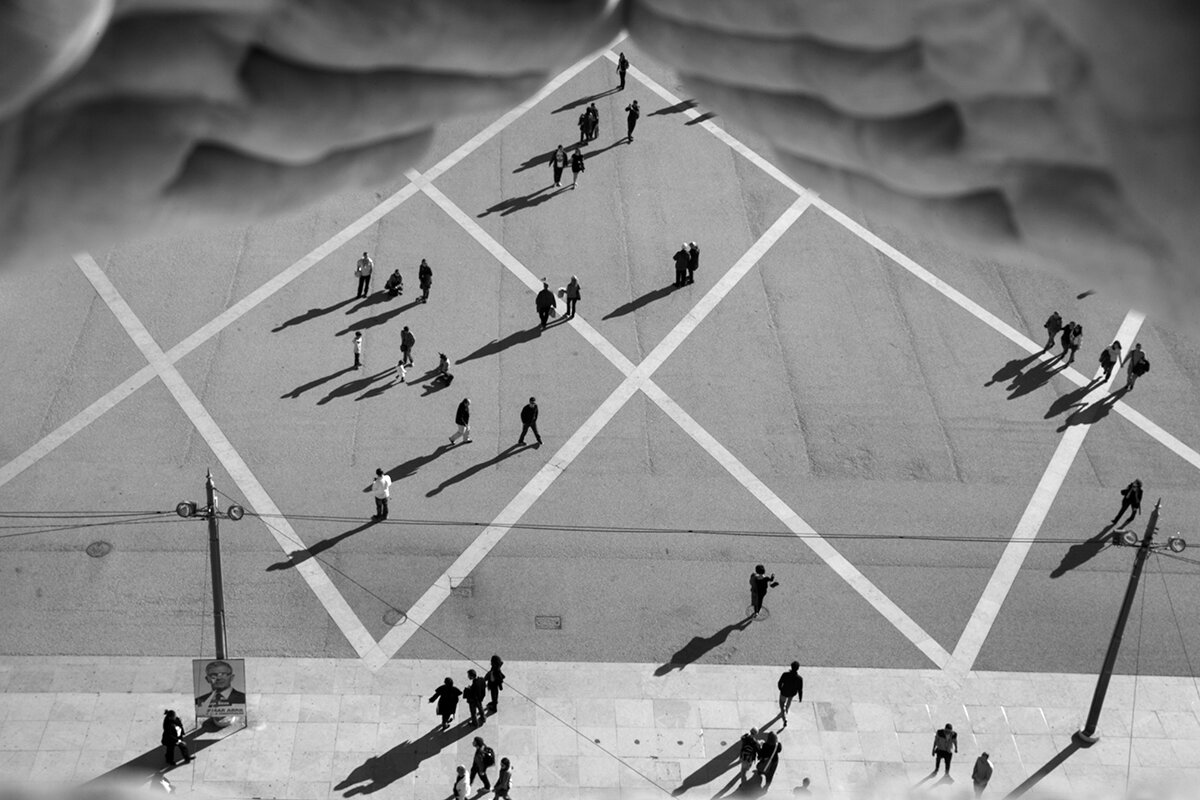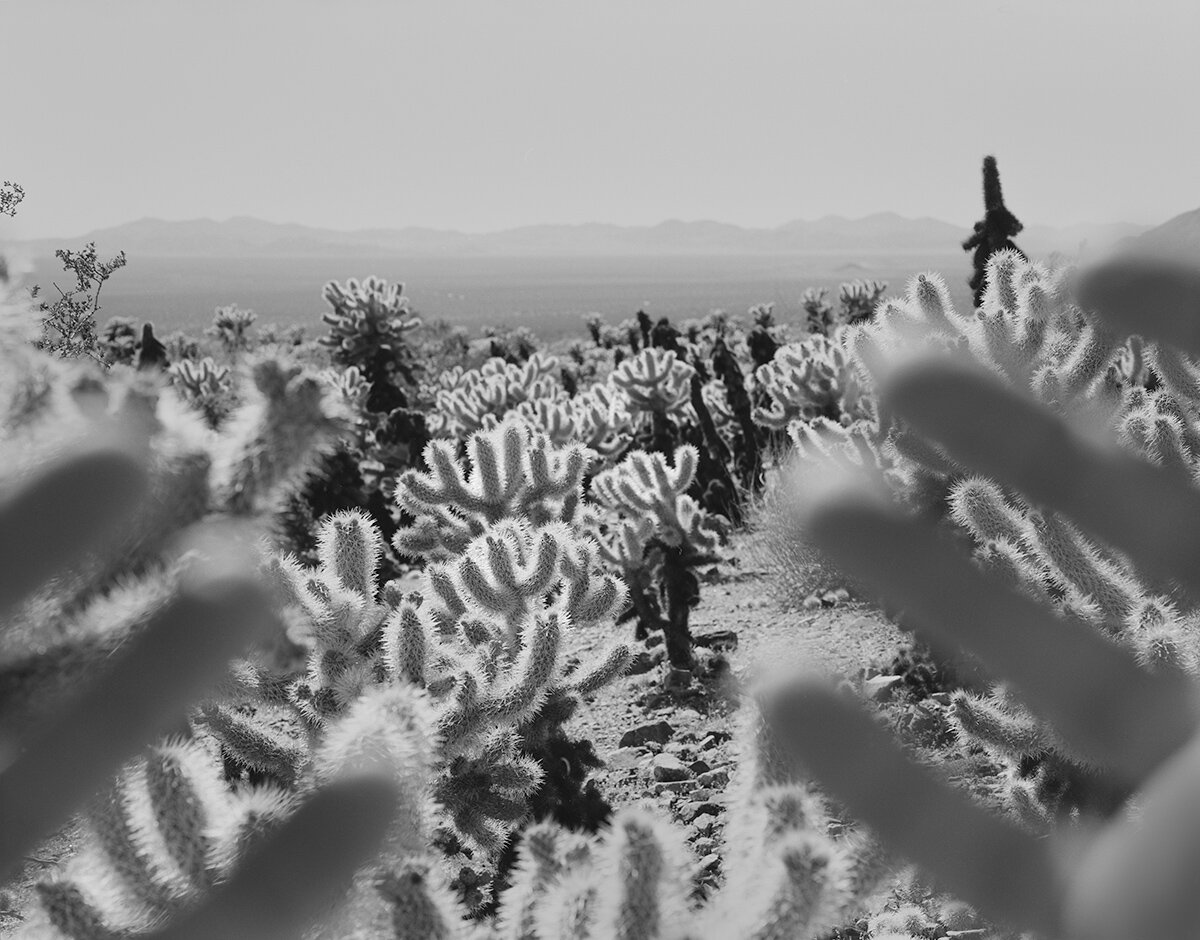 |
| Mountain Lakes, NJ, 1977. © Arno Rafael Minkkinen. Courtesy of the artist and Edwynn Houk Gallery, New York. |
Edwynn Houk Gallery’s
Arno Rafael Minkkinen: Fifty Years ambitiously uses fifteen individual black-and-white photographs to encompass the entirety of the photographer’s five-decade-long career. Minkkinen’s photographs have been carefully chosen to display how he pushes the limits of the form and subject matter--not only in the use of setting and figure but also in the variation of tone and emotional response, all without including a human face. Landscape photography skeptics and agnostics may well be convinced and converted.
Apart from the awe they inspire, there are elements of comedy, charm, and even horror in these photographs. It all depends on the degree to which Minkkinen absorbs the human body into the outdoor landscape or setting. In
Praça de Comércio, Lisbon, Portugal (2015), for example, a slightly blurry pair of hands at the top of the image frame a high-angle looking down onto a crisp, gridded plaza. At first glance, it looks like something out of Terry Gilliam’s Monty Python cartoons, as if a stop-motion animated God figure will descend from the parting clouds and deliver a sarcastic proclamation. It’s an unexpected work in the context of what initially appears to be a serious set of glossy black-and-white images. Placed in the first of two gallery rooms,
Praça de Comércio and its Modernist evocation of a flat pictorial surface catches the eye immediately and sets the tone for a much more playful and inventive exhibit that one might expect.
 |
| Praça de Comércio, Lisbon, Portugal, 2015. © Arno Rafael Minkkinen. Courtesy of the artist and Edwynn Houk Gallery, New York |
The same quirky joy appears in Stranda, Norway (2006), a true highlight of the show, in which the unexpected use of the human body comes across almost as camouflage, appearing totally natural within the landscape context. A line of thin-trunked trees stands before a lake-mountain backdrop, with the sun shimmering on the surface of the water. On a second look, it becomes clear that one of the trees does not have a forked set of branches, but bends far to the right side, with a single human leg standing in to continue the straight line of the other two trees. There’s no other indication of a human body, leading you to wonder how long the model had to stand perfectly still on that perch to get the shot, yet it looks totally spontaneous as if the model has just landed on that curve of trunk and is alighting there like some mysterious fairy-tale creature.
 |
| Stranda, Norway, 2006. © Arno Rafael Minkkinen. Courtesy of the artist and Edwynn Houk Gallery, New York. |
In
Ismo's Stick, Fosters Pond (1993), this same distorting of the human body in rhythm with plants takes the form of a seemingly-headless person, depicted from behind, holding a thick branch aloft. Reflected in a body of water, the human and branch and reflection almost seem to form a figure eight, making the boundaries among flesh, stick, and water are not quite clear.
 |
| Ismo's Stick, Fosters Pond, 1993. © Arno Rafael Minkkinen. Courtesy of the artist and Edwynn Houk Gallery, New York. |
|
|
In these works, there’s often a careful balancing act of who is acting upon whom. In
Halfway Up Mt. Mitchell, Burnsville, NC (2013), a single hand extends and appears, through the magic of foreshortening, to grasp the base of a tree far in the distance, as if holding a bouquet of freshly-picked flowers.
Mountain Lakes, NJ (1977) feels almost monumental in its depiction of three isolated fingers (or perhaps toes) up close, without the context of any other parts of a human body. The blurry dark ground behind these pale fingers lends an eerie air to their presence as if left behind in this indistinct setting for an unexplained reason.
The tour-de-force
Joshua Tree, California (2011), takes Minkkinen’s adept use of human forms to simulate and even replace elements of the landscape to its darkest point, conjuring an unsettling feeling of dread. Once again, Minkkinen confronts viewers with two blurry hands—or, rather, two sets of fingers, with the palms cut off by the composition—in front of a field of cactus plants, their spines looking like raised arm-hairs, practically shuddering with intent. We are so accustomed, after taking in Minkkinen’s output in
Fifty Years, to a gentle blurring of the human-nature boundary that it’s as if the fingers in the foreground are in the process of becoming cacti—as if some horrible science fiction transmogrification has occurred, and all we can do is watch as the human subject holds their hands up to their eyes and is powerless to stop their mutation and transformation from fauna to flora.
 |
| Joshua Tree, California, 2011. © Arno Rafael Minkkinen. Courtesy of the artist and Edwynn Houk Gallery, New York. |
In
From the Shelton Hotel Looking East (2005), a pair of hands emerge from the sides of the image and appear to pull apart two skyscrapers like parting curtains, revealing a breadth of negative space in the center. As in
Praça de Comércio, it makes you wonder where the camera is placed to capture that shot. And yet, looking around to see how Minkkinen considers and manipulates the human body to stand in for elements of the landscape, it’s easy to see a converse in
Shelton Hotel and other works where the camera takes a point-of-view position. The human eye itself becomes the technology, just as the limbs become nature.
 |
| From the Shelton Hotel Looking East, 2005. © Arno Rafael Minkkinen. Courtesy of the artist and Edwynn Houk Gallery, New York. |
The comprehensive time span of
Fifty Years even lends a certain credence to the idea that as Minkkinen becomes more adept and confident in his photographic process, the outcome is a total sublimation of the artist into the works themselves.






Comments
Post a Comment